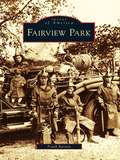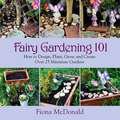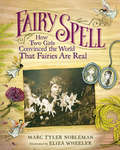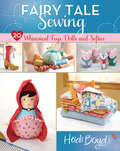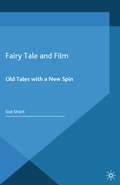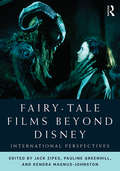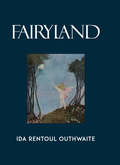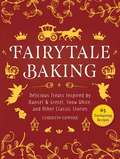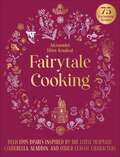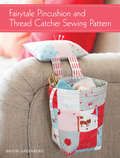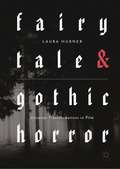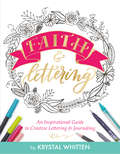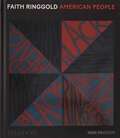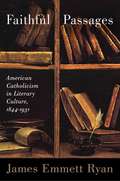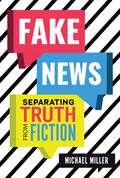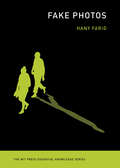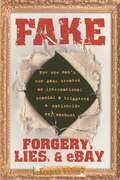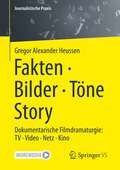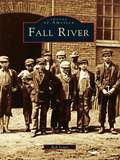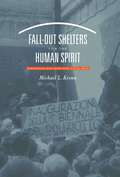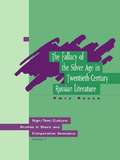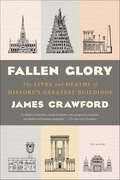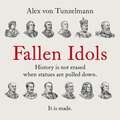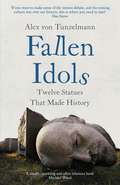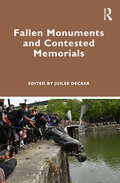- Table View
- List View
Fairview Park (Images of America)
by Frank BarnettFairview Park is truly a postwar community. Before World War II, it was mainly rural countryside just beginning to see some development. The Rocky River valley had been enough of a barrier to keep Fairview that much more rural until high-level bridges were built in the 1920s. A brochure at the time for the newly developed Coffinberry Estates in northeast Fairview Park refers to "quick access to downtown Cleveland via Hilliard Road, Detroit Avenue, or Lorain Avenue bridges." The bridges residents now take for granted were then a major selling point. The farmland started to evolve into suburbia as spaces between houses were filled with more houses. Fairview Village became Fairview Park in 1948, and the year before, Cuyahoga County's first shopping center was built here.
Fairy Gardening 101: How to Design, Plant, Grow, and Create Over 25 Miniature Gardens
by Fiona McdonaldRelease your inner child and step into the fairy world by creating your own enchanted garden, no matter how much space you have! Fairy gardens are increasing in popularity and Fairy Gardening 101 provides you with all the information necessary to design, plant, and care for your very own miniature garden oasis. Author, artist, and fairy gardener extraordinaire Fiona McDonald introduces readers to the history of fairy gardens and then provides step-by-step instructions, photographs, and illustrations for you to follow-or draw inspiration from-when starting your own project.Learn which types of plants and containers are most successful for a fairy garden, as well as how to develop a focal point for your enchanted mini Eden. Fairy Gardening 101 also provides important information on caring for your garden, on designing gardens for both indoors and outside, on using artificial plants to make your garden last a lifetime, and much more! You'll also find inspirational photos from fairy gardeners around the globe as well as a list of suppliers. You don't need to be a master gardener or to have a particularly green thumb to successfully plant and maintain your tiny fairy garden. All you need is a few miniature plants, some thoughtfully placed accessories, a fairy or two, and a love of whimsy and imagination.
Fairy Spell: How Two Girls Convinced the World That Fairies Are Real
by Marc Tyler Nobleman Eliza WheelerIn 1917, in Cottingley, England, a girl named Elsie took a picture of her younger cousin, Frances. Also in the photo was a group of fairies, fairies that the girls insisted were real. Through a remarkable set of circumstances, that photograph and the ones that followed came to be widely believed as evidence of real fairies. It was not until 1983 that the girls, then late in life, confessed that the Cottingley Fairies were a hoax. <P><P> Their take is an extraordinary slice of history, from a time when anything in a photograph was assumed to be fact and it was possible to trick an eager public into believing something magical. Exquisitely illustrated with art and the original fairy photographs.
Fairy Tale Sewing: 20 Whimsical Toys, Dolls and Softies
by Heidi BoydSew your way to happily ever after! Bring story time to life with this collection of imaginative projects. Drawing inspiration from classic fairy tales, author Heidi Boyd adds a modern twist to everything from huggable softies such as the magical Unicorn to interactive toys such as Snow White's Cottage Tote. Sleeping Beauty's Castle Quilt brings sweet dreams to any child's room, and the Rapunzel Pillow is perfect for cuddling and play. Readily available cottons, felts, yarns and embroidery floss plus clear instructions and detailed illustrations make sewing simple and straightforward so you can spend less time sewing and more time enjoying your favorite fairy tales.
Fairy Tale and Film: Old Tales with a New Spin
by S. ShortSue Short examines how fairy tale tropes have been reworked in contemporary film, identifying familiar themes in a range of genres – including rom coms, crime films and horror – and noting key similarities and differences between the source narratives and their offspring.
Fairy-Tale Films Beyond Disney: International Perspectives
by Jack Zipes Pauline Greenhill Kendra Magnus-JohnstonThe fairy tale has become one of the dominant cultural forms and genres internationally, thanks in large part to its many manifestations on screen. Yet the history and relevance of the fairy-tale film have largely been neglected. In this follow-up to Jack Zipes’s award-winning book The Enchanted Screen (2011), Fairy-Tale Films Beyond Disney offers the first book-length multinational, multidisciplinary exploration of fairy-tale cinema. Bringing together twenty-three of the world’s top fairy-tale scholars to analyze the enormous scope of these films, Zipes and colleagues Pauline Greenhill and Kendra Magnus-Johnston present perspectives on film from every part of the globe, from Hayao Miyazaki’s Spirited Away, to Jan Švankmajer’s Alice, to the transnational adaptations of 1001 Nights and Hans Christian Andersen. Contributors explore filmic traditions in each area not only from their different cultural backgrounds, but from a range of academic fields, including criminal justice studies, education, film studies, folkloristics, gender studies, and literary studies. Fairy-Tale Films Beyond Disney offers readers an opportunity to explore the intersections, disparities, historical and national contexts of its subject, and to further appreciate what has become an undeniably global phenomenon.
Fairyland
by Annie R. Rentoul Grenbry Outhwaite Ida Rentoul OuthwaiteA highly sought-after collectible, Fairyland features the exquisite illustrations of Ida Rentoul Outhwaite, a noted artist of the early 20th century. Outhwaite excelled at the depiction of dainty sprites, and her whimsical visions are highlighted by images of kangaroos, koalas, kookaburras, and other creatures of her native Australia. Her art -- with accompanying verses by her sister, Annie R. Rentoul, and stories by her husband, Grenbry Outhwaite --is populated by princesses, witches, pixies, and other folkloric creatures and abounds in timeless charm. This hardcover edition of Outhwaite's most lavish work features dozens of graceful and imaginative illustrations, including nineteen in full color.
Fairytale Baking: Delicious Treats Inspired by Hansel & Gretel, Snow White, and Other Classic Stories
by Christin Geweke75 enchanting and delicious treats inspired by The Princess and the Pea, Mother Holle, and more! Like old family recipes, fairytales and stories are also handed down from one generation to the next. And delicious baking can delight the senses and bring back memories just like a good story, for both old and young alike. This journey through magical baking will make you dream of fairytale forests and faraway lands. These enchanting recipes are guaranteed to be liked by even the fussiest of cake eaters. Learn to make delicious pastries and desserts such as: •Black Forest Cherry Trifle•Meringue Cake•Coconut Crumble Pineapple Muffins•Chocolate and Espresso Biscotti•Salted Peanut Cupcakes•Mini Lava Cakes•Chocolate Hazelnut Swiss Roll•Mini Chocolate Mousse Flans•Blackberry Ganache Tartlets•Crème Brûlée•Mini Cinnamon Rolls•Mango and Chocolate Squares•Spiced Macarons•Chocolate Bourbon Cupcakes•Sweet Berry Cobbler•Marbled Cheesecake•And Much More! Also included within are fairytales to help pass the time until your goodies are ready to take out of the oven and devour!
Fairytale Cooking: Delicious Dishes Inspired by The Little Mermaid, Cinderella, Aladdin, and Other Classic Characters
by Alexander Höss-KnakalRediscover your favorite childhood fairytales through these delightful and exquisite feasts! Fairytales become classics, passed down for hundreds of years, not only because of the nostalgia provoked, but also because of the values they can teach us—the importance of family and friendship, patience, persistence, courage—these lessons become just as cherished as the stories themselves. This timeless nature is precisely what fairytales and cooking have in common: The wisdom of fairytales and the soul of good cooking can last for centuries. Stories and recipes are passed on from one generation to the next; from parents to children and from children to grandchildren. Just like treasured stories, favorite dishes and recipes never go out of fashion either—as soon as the familiar aroma of a traditional Sunday roast wafts through the home, it evokes an irresistible feeling of delight. Like the tales themselves, recipes are also capable of transporting us to new and exciting worlds. Here you'll find recipes such as: Button mushroom flatbread with hazelnut pesto, inspired by Little Red Riding Hood and The WolfRisotto with smoked salmon and fennel, inspired by The Little MermaidTomato and zucchini tarte tatin, inspired by Beauty and the BeastSpicy red dhal with a coriander dip, inspired by Aladdin and The Magic LampDuck breast with butternut squash and king trumpet mushrooms, inspired by CinderellaPasta with radicchio, gorgonzola, and walnuts, inspired by The Snow QueenAnd more!
Fairytale Pincushion and Thread Catcher Sewing Pattern
by Brioni GreenbergThis pretty project uses pre-cut charm squares to create a simple yet decorative sewing accessory. Place it on a table or shelf near your work to avoid the problem of dropping pins and scattered loose threads! Project taken from 25 Ways to Sew Jelly Rolls, Layer Cakes and Charm Packs by Brioni Greenberg
Fairytale and Gothic Horror: Uncanny Transformations in Film
by Laura HubnerThis book explores the idiosyncratic effects generated as fairytale and gothic horror join, clash or merge in cinema. Identifying long-held traditions that have inspired this topical phenomenon, the book features close analysis of classical through to contemporary films. It begins by tracing fairytale and gothic origins and evolutions, examining the diverse ways these have been embraced and developed by cinema horror. It moves on to investigate films close up, locating fairytale horror, motifs and themes and a distinctively cinematic gothic horror. At the book’s core are recurring concerns including: the boundaries of the human; rational and irrational forces; fears and dreams; ‘the uncanny’ and transitions between the wilds and civilization. While chronology shapes the book, it is thematically driven, with an interest in the cultural and political functions of fairytale and gothic horror, and the levels of transgression or social conformity at the heart of the films.
Faith & Lettering: An Inspirational Guide to Creative Lettering & Journaling (Deluxe Signature Journals)
by Krystal WhittenSomething special happens when you learn to write or draw God's Word. In Faith and Lettering, Krystal Whitten's advice and encouragement will help you draw near to God and pursue a deeper faith by expressing your creativity. You will learn three basic types of letters and variations on them, what tools to use and how to use them, and step-by-step instructions for decorative flourishes and embellishments. Krystal will also show you how to find inspiration and accept grace when mistakes happen. Her inspiring tips, techniques, and ideas will help make your Bibles, journals, and home decor uniquely your own.
Faith Ringgold: American People
by Massimiliano Gioni Gary Carrion-MurayariThe most comprehensive survey to date of the work of Faith Ringgold, whose groundbreaking art and political activism span more than sixty years—featuring a stellar line-up of contributors and an unprecedented collection of images <p><p> Faith Ringgold is a critically acclaimed American artist whose unique methods of visual storytelling have documented and advanced art historical, feminist, and civil-rights movements for more than half a century. Accompanying a major retrospective at the New Museum, New York, this expansive survey covers work from all periods of her career, including her early civil rights–era figurative paintings, her graphic political protest posters, and her signature experimental story quilts.
Faithful Passages: American Catholicism in Literary Culture, 1844-1931
by James Emmett RyanRoman Catholic writers in colonial America played only a minority role in debates about religion, politics, morality, national identity, and literary culture. However, the commercial print revolution of the nineteenth century, combined with the arrival of many European Catholic immigrants, provided a vibrant evangelical nexus in which Roman Catholic print discourse would thrive among a tightly knit circle of American writers and readers. James Emmett Ryan's pathbreaking study follows the careers of important nineteenth-century religionists including Orestes Brownson, Isaac Hecker, Anna Hanson Dorsey, and Cardinal James Gibbons, tracing the distinctive literature that they created during the years that non-Catholic writers like Herman Melville and Emily Dickinson were producing iconic works of American literature. Faithful Passagesalso reveals new dimensions in American religious literary culture by moving beyond the antebellum period to consider how the first important cohort of Catholic writers shaped their message for subsequent generations of readers in the late nineteenth and early twentieth centuries. Perhaps most strikingly, Ryan shows that by the early twentieth century, Roman Catholic themes and traditions in American literature would be advanced in complex ways by mainstream, non-Catholic modernist writers like Kate Chopin and Willa Cather. Catholic literary culture in the United States took shape in a myriad of ways and at the hands of diverse participants. The process by which Roman Catholic ideas, themes, and moralities were shared and adapted by writers with highly differentiated beliefs, Ryan contends, illuminates a surprising fluidity of religious commitment and expression in early U. S. literary culture.
Fake News: Separating Truth from Fiction
by Michael MillerWhile popularized by President Donald Trump, the term "fake news" actually originated toward the end of the 19th century, in an era of rampant yellow journalism. Since then, it has come to encompass a broad universe of news stories and marketing strategies ranging from outright lies, propaganda, and conspiracy theories to hoaxes, opinion pieces, and satire—all facilitated and manipulated by social media platforms. This title explores journalistic and fact-checking standards, Constitutional protections, and real-world case studies, helping readers identify the mechanics, perpetrators, motives, and psychology of fake news. A final chapter explores methods for assessing and avoiding the spread of fake news.
Fake Photos (The MIT Press Essential Knowledge Series)
by Hany FaridA concise and accessible guide to techniques for detecting doctored and fake images in photographs and digital media. Stalin, Mao, Hitler, Mussolini, and other dictators routinely doctored photographs so that the images aligned with their messages. They erased people who were there, added people who were not, and manipulated backgrounds. They knew if they changed the visual record, they could change history. Once, altering images required hours in the darkroom; today, it can be done with a keyboard and mouse. Because photographs are so easily faked, fake photos are everywhere—supermarket tabloids, fashion magazines, political ads, and social media. How can we tell if an image is real or false? In this volume in the MIT Press Essential Knowledge series, Hany Farid offers a concise and accessible guide to techniques for detecting doctored and fake images in photographs and digital media. Farid, an expert in photo forensics, has spent two decades developing techniques for authenticating digital images. These techniques model the entire image-creation process in order to find the digital disruption introduced by manipulation of the image. Each section of the book describes a different technique for analyzing an image, beginning with those requiring minimal technical expertise and advancing to those at intermediate and higher levels. There are techniques for, among other things, reverse image searches, metadata analysis, finding image imperfections introduced by JPEG compression, image cloning, tracing pixel patterns, and detecting images that are computer generated. In each section, Farid describes the techniques, explains when they should be applied, and offers examples of image analysis.
Fake: Forgery, Lies, & Ebay
by Kenneth WaltonIt was the golden age of eBay. Optimistic bidders went online to the world's largest flea market in droves, ready to spend cash on everything from garden gnomes to Mercedes convertibles. Among them were art collectors willing to spend big money on unseen paintings, hoping to buy valuable pieces of art at below-market prices. EBay also attracted the occasional con artist unable to resist the temptation of abusing a system that prided itself on being "based on trust. " Kenneth Walton -- once a lawyer bound by the ethics of his profession to uphold the law -- was seduced by just such a con artist and, eventually, became one himself. Ripped from the headlines of the New York Times, the first newspaper to break the story, Fake describes Walton's innocent beginnings as an online art-trading hobbyist and details the downward spiral of greed that ultimately led to his federal felony conviction. What started out as a satisfying exercise in reselling thrift store paintings for a profit in order to pay back student loans and mounting credit card debt soon became a fierce addiction to the subtle deception of luring unsuspecting bidders into overpaying for paintings of questionable origins. In a landscape peopled with colorful eccentrics hoping to score museum-quality paintings at bargain prices, Walton entered into a partnership with Ken Fetterman, an unslick (yet somehow very effective) con man. Over the course of eighteen months they managed to take in hundreds of thousands of dollars by selling forged paintings and bidding on their own auctions to drive up the prices. When their deception was discovered and made international headlines, Walton found himself stalked by reporters and federal agents while Fetterman went on the lam, sparking a nationwide FBI manhunt. His elaborate game of cat and mouse lasted nearly three years, until the feds caught up with him after a routine traffic violation and brought him to justice. In this sensational story of the seductive power of greed, Kenneth Walton breaks his silence for the first time and, in his own words, details the international scandal that forever changed the way eBay does business.
Fakten · Bilder · Töne · Story: Dokumentarische Filmdramaturgie: TV · Video · Netz · Kino (Journalistische Praxis)
by Gregor Alexander HeussenDokumentarische Filme aller Genres in TV, Kino und Netz entfalten ihre informative Kraft erst dann, wenn sie dramaturgisch als Erzählungen strukturiert sind, nicht als Aufzählungen. Sie müssen die Emotionen des Publikums wecken, damit die filmische Information verstanden werden kann. Wirksame dokumentarische Filmgestaltung ist begründet in der Art, wie Menschen hinschauen und hinhören. Ihre Wahrnehmungen werden zu Vorstellungen; diese prägen die Information. Dadurch verändern sich viele überkommene Regeln für Dokumentarische Filme. Neue Ideen werden möglich. Werkzeuge dafür sind der Erzählsatz, die Roten Fäden, die Drama-Elementarmuster, das konzentrierte Zusammenspiel der sechs filmischen Erzähler, Emotionsziel und Argumentziel und die für Erzählungen charakteristische Polaritätslogik. Anders als fiktionale Filme müssen Dokumentarische Filme durch ihre erzählerische Struktur und filmische Gestaltung einen nachprüfbaren Bezug zur Lebensrealität des Publikums schaffen. Spielfilme hingegen können in ihrem jeweils definierten Erzählkosmos plausibel und authentisch sein. Im Dokumentarischen lassen sich auch Werkzeuge und Muster der Fiktionalen Dramaturgie nutzen, aber mit anderer Absicht und Wirkung: sie müssen die Lebensrealität treffen. Das Buch von Gregor Alexander Heussen zeigt Dokumentarische Dramaturgie praktisch; und begründet sie mit Erkenntnissen der Kognitionswissenschaft. Redakteure* und Film-Auftraggeber* finden Werkzeuge und Denkwege für Planung, und Filmabnahme. Autoren* erfahren die Kraft der dramaturgischen Recherche und entdecken neue Gestaltungsmöglichkeiten bei Dreh und Montage. Das Buch ist ein Muss für alle, die sich für dokumentarischen Film in TV, Kino, Netz und Unternehmen interessieren. Mit dem Buch sind 29 runterladbare, sofort nutzbare Drama-Werkzeuge verlinkt.
Fall River (Images of America)
by Rob LewisThe city known today as Fall River, Massachusetts, considered until 1803 to be a part of Freetown and until 1862 to be partially contained within the boundaries of Rhode Island, came into its own as a great industrial city in the latter half of the nineteenth century. The massive power of the Quequechan River fueled several mills, and Fall River granite provided the basis for a developing stone-cutting business. Over the years, the city's numerous villages have been home to many hard-working and loyal residents. These residents historically have much to be proud of: in many ways Fall River led the region in the development of technology and public education. By the 1880s, the city was equipped with telephones, streetcars, and electrical service, and the B.M.C. Durfee High School-opened in 1886-was considered the finest in the nation. Through the 200-plus photographs and informative captions in this marvelous new visual history, local author Rob Lewis seeks to remind residents of Fall River's glorious past; his work also suggests the future potential of this significant American city as we approach the millennium.
Fall-Out Shelters for the Human Spirit
by Michael L. KrennDuring the Cold War, culture became another weapon in America's battle against communism. Part of that effort in cultural diplomacy included a program to arrange the exhibition of hundreds of American paintings overseas. Michael L. Krenn studies the successes, failures, contradictions, and controversies that arose when the U.S. government and the American art world sought to work together to make an international art program a reality between the 1940s and the 1970s. The Department of State, then the United States Information Agency, and eventually the Smithsonian Institution directed this effort, relying heavily on the assistance of major American art organizations, museums, curators, and artists. What the government hoped to accomplish and what the art community had in mind, however, were often at odds. Intense domestic controversies resulted, particularly when the effort involved modern or abstract expressionist art. Ultimately, the exhibition of American art overseas was one of the most controversial Cold War initiatives undertaken by the United States. Krenn's investigation deepens our understanding of the cultural dimensions of America's postwar diplomacy and explores how unexpected elements of the Cold War led to a redefinition of what is, and is not, "American."
Fallacy of Silver Age
by Omry RonenIn this study, Ronen critically examines the term "Silver Age", which over the years has gained such wide currency among historians and connoisseurs of 20th century Russian culture. The author traces the origin and the controversial development of what he condemns as an influential misnomer. Ronen sets out to debunk the myth that attributes invention of the term to Nikolai Berdiaev, and in turn traces this widely used catchword in the critical idiom from an abscure, avante-garde manifesto to the present day. He lays to rest the use of the term which he sees as the most misleading constituent of Russia's contemporary cultural self-awareness and self-assessment.
Fallen Glory: The Lives and Deaths of History's Greatest Buildings
by James Crawford“A narrative that spans seven millennia, five continents and even reaches into cyberspace. . . . I savored each page.” —Henry Petroski, Wall Street JournalIn Fallen Glory, James Crawford uncovers the biographies of some of the world’s most fascinating lost and ruined buildings, from the dawn of civilization to the cyber era. The lives of these iconic structures are packed with drama and intrigue, featuring war and religion, politics and art, love and betrayal, catastrophe and hope. They provide the stage for a startling array of characters, including Gilgamesh, the Cretan Minotaur, Agamemnon, Nefertiti, Genghis Khan, Henry VIII, Catherine the Great, Adolf Hitler, and even Bruce Springsteen.The twenty-one structures Crawford focuses on include The Tower of Babel, The Temple of Jerusalem, The Library of Alexandria, The Bastille, Kowloon Walled City, the Berlin Wall, and the Twin Towers of the World Trade Center. Ranging from the deserts of Iraq, the banks of the Nile and the cloud forests of Peru, to the great cities of Jerusalem, Istanbul, Paris, Rome, London and New York, Fallen Glory is a unique guide to a world of vanished architecture. And, by picking through the fragments of our past, it asks what history’s scattered ruins can tell us about our own future.“Witty and memorable . . . moving as well as myth-busting.” —Times Literary Supplement (UK)“[An] elegant, charged book . . . A well-written prize for students of history, archaeology, and urban planning.” —Kirkus Reviews, starred review“Astute, entertaining, and affecting.” —Booklist“A lovely, wise book.” —Alexander McCall Smith, New Statesman (UK)“A cabinet of curiosities, a book of wonders with unexpected excursions and jubilant and haunting marginalia.” —Spectator (UK)
Fallen Idols: History is not erased when statues are pulled down. It is made.
by Alex von Tunzelmann'Alex von Tunzelmann is one of the most gifted historians writing today. Brilliant and trenchant, witty and wise, Fallen Idols is a book you will adore, devour, and talk about to everyone you know. Hesitate no longer; buy this book.' Suzannah Lipscomb, author, award-winning historian and broadcaster'Like all the best historians von Tunzelmann uses the past to explain what the hell is going on today. She does so with a flair, her signature mix of scholarship and succinctness that is so compelling. If you want to make sense of the statues debate, and the coming culture war over our history, this is where you need to start.' Dan Snow'A timely, sparkling and often hilarious book.' Michael Wood A hugely entertaining and informative narrative on one of the key arguments raging across the globe - how does one honestly celebrate a country's past without knocking down celebrated heroes.In 2020, statues across the world were pulled down in an extraordinary wave of global iconoclasm. From the United States and the United Kingdom to Canada, South Africa, the Caribbean, India, Bangladesh, and New Zealand, Black Lives Matter protests defaced and hauled down statues of slaveholders, Confederates, and imperialists. Edward Colston was hurled into the harbour in Bristol, England. Robert E. Lee was covered in graffiti in Richmond, Virginia. Christopher Columbus was toppled in Minnesota, beheaded in Massachusetts, and thrown into a lake in Virginia. King Leopold II of the Belgians was set on fire in Antwerp and doused in red paint in Ghent. Winston Churchill was daubed with the word 'racist' in London.Statues are one of the most visible - and controversial - forms of historical storytelling. The stories we tell about history are vital to how we, as societies, understand our past and create our future. So whose stories do we tell? Who or what defines us? What if we don't all agree? How is history made, and why?FALLEN IDOLS looks at twelve statues in modern history. It looks at why they were put up; the stories they were supposed to tell; why those stories were challenged; and how they came down.History is not erased when statues are pulled down. If anything, it is made.(P)2021 Headline Publishing Group Limited
Fallen Idols: Twelve Statues That Made History
by Alex Von Tunzelmann'Alex von Tunzelmann is one of the most gifted historians writing today. Brilliant and trenchant, witty and wise, Fallen Idols is a book you will adore, devour, and talk about to everyone you know. Hesitate no longer; buy this book.' Suzannah Lipscomb, author, award-winning historian and broadcaster'Like all the best historians von Tunzelmann uses the past to explain what the hell is going on today. She does so with a flair, her signature mix of scholarship and succinctness that is so compelling. If you want to make sense of the statues debate, and the coming culture war over our history, this is where you need to start.' Dan Snow'A timely, sparkling and often hilarious book.' Michael Wood In 2020, statues across the world were pulled down in an extraordinary wave of global iconoclasm. From the United States and the United Kingdom to Canada, South Africa, the Caribbean, India, Bangladesh, and New Zealand, Black Lives Matter protests defaced and hauled down statues of slaveholders, Confederates, and imperialists. Edward Colston was hurled into the harbour in Bristol, England. Robert E. Lee was covered in graffiti in Richmond, Virginia. Christopher Columbus was toppled in Minnesota, beheaded in Massachusetts, and thrown into a lake in Virginia. King Leopold II of the Belgians was set on fire in Antwerp and doused in red paint in Ghent. Winston Churchill was daubed with the word 'racist' in London.Statues are one of the most visible - and controversial - forms of historical storytelling. The stories we tell about history are vital to how we, as societies, understand our past and create our future. So whose stories do we tell? Who or what defines us? What if we don't all agree? How is history made, and why?FALLEN IDOLS looks at twelve statues in modern history. It looks at why they were put up; the stories they were supposed to tell; why those stories were challenged; and how they came down.History is not erased when statues are pulled down. If anything, it is made.
Fallen Monuments and Contested Memorials
by Juilee DeckerFallen Monuments and Contested Memorials examines how the modification, destruction, or absence of monuments and memorials can be viewed as performative acts that challenge prescribed, embodied narratives in the public realm. Bringing together international, multidisciplinary approaches, the chapters in this volume interrogate the ways in which memorial constructions disclose implicitly and explicitly the proxy battle for public memory and identity, particularly since 2015. Acknowledging the ways in which the past — which is given agency through monuments and memorials — intrudes into daily life, this volume offers perspectives from researchers that answer questions about the roles of monuments and memorials as persistent, yet mutable, works whose meanings are not fixed but are, rather, subject to processes of continual re-interpretation. By using monuments and memorials as lenses through which to view race, memory, and the legacies of war, power, and subjugation, this volume demonstrates how these works, and their visible representations of entitlement, possession, control, and authority, can offer the opportunity to pose and answer questions about whose memory matters and what our symbols say about who we are and what we value. Fallen Monuments and Contested Memorials is essential reading for scholars and students studying cultural heritage, history, art history, and public history. It will be particularly useful to those with an interest in public monuments and memorials; colonial and post-colonial history; memory studies; and nationalism, race, and ethnic studies.
